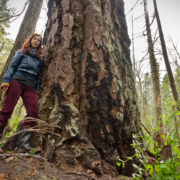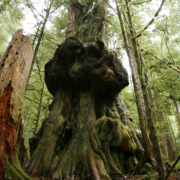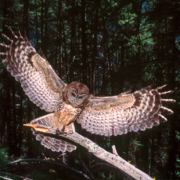If the northern spotted owl is healthy, it’s a good sign that the old-growth forests where it lives are healthy. Unfortunately, the spotted owl is not doing well in British Columbia, the only place it lives in Canada. Only six of the beautiful brown-eyed birds remain here.
Spotted owls live up to 17 years in the wild, but they breed slowly, mating for life and producing just one or two chicks every two years. Silent hunters with excellent vision and hearing, the owls swoop through the open canopy of old-growth forests at dusk to catch wood rats, voles, mice, and squirrels. At one time, at least 500 pairs lived in B.C.’s forests, but over the past 100 years, their habitat has been so heavily logged that the owls have been unable to survive.
Spotted owls are particularly vulnerable to logging because of the way they nest and hunt. The owls don’t build nests but lay eggs in trees hollowed out by age or decay. And when a forest is cleared and prey populations decline, the birds often starve.
The B.C. government is belatedly trying to save the owls, with plans to capture two of the remaining males to breed with two single females in captivity. The government now has 10 owls in its breeding program and hopes to have 30 or 40 pairs so that 70 or so of the birds can be released back into the wilderness in the next decade. Government biologists have also been killing barred owls, which compete with the spotted owls for habitat.
The government has had a habitat conservation plan in place since 1997, but it was based on the premise that owl populations and habitat would be maintained only as long as those efforts did not lead to more than a 10 per cent reduction in the long-term timber supply over current levels. In 2003, the B.C. government allowed logging to proceed in six of the remaining 10 areas where spotted owls were found.
More than 70 per cent of the owls’ old-growth habitat, ranging from northern California to southwestern B.C., has now been logged. The spotted owl is listed as an endangered species in both Canada and the United States, with only a few thousand pairs remaining.
It doesn’t help that B.C. has no legislation to protect species at risk. Although the spotted owl is listed as endangered under federal law, Canada’s Species at Risk Act only applies to federal lands. If an owl were to take up residence at a post office or federal airport, it would be legally protected, but in the province’s old-growth forests, it is afforded no such status.
Why should we care? Well, beyond the fact that allowing any species to go extinct because of our activities is a pretty sorry indicator of our ability to manage our affairs, the spotted owl’s health, as we mentioned, gives us a pretty good indication about the health of the entire old-growth ecosystem. And when one species goes extinct, the effects cascade throughout the ecosystem.
We also know many plants and animals besides the spotted owl rely on old-growth forests for their survival. If habitat loss is threatening the survival of the owl, it is surely threatening the survival of other species as well.
In fact, a study we conducted found that one quarter of the plants and animals that share the spotted owl’s old-growth habitat in B.C.’s Lower Mainland are also at risk of disappearing, including tailed frogs, coastal marbled murrelets, northern goshawks, and fishers.
We must demand that the provincial government put an end to logging in old-growth forests and allow more second-growth forests to mature if we are to ensure the survival of the spotted owl and other old-growth dependent plants and animals. We also need a provincial law to protect plants and animals in B.C. that are at risk of disappearing, such as spotted owls, orcas, and grizzly bears.
It’s just not good enough to wait until an animal has all but disappeared and then scramble to try to bring it back. When we harm one animal and the ecosystem of which it is a part, we affect everything that is connected to it, including ourselves. The spotted owl’s fate should tell us something about ourselves. What kind of animal are we that put our economic and political agendas ahead of the very survival of another species?





